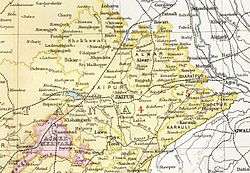Lawa Thikana
| Lawa State लावा | |||||
| Princely State of British India | |||||
| |||||
 | |||||
| Capital | Lawa | ||||
| Government | Principality | ||||
| History | |||||
| • | Established | 1772 | |||
| • | Acceded to India | 1947 | |||
| Area | |||||
| • | 1901 | 49 km2 (19 sq mi) | |||
| Population | |||||
| • | 1901 | 2,671 | |||
| Density | 54.5 /km2 (141.2 /sq mi) | ||||
| Today part of | Rajasthan, India | ||||
Lawa Thikana was a Thikana estate or Thakurat under the Jaipur Residency of the former Rajputana Agency.[1] It was located very close to Tonk town and included its capital, Lawa, a small town and its surroundings. Lawa is located in the northwestern part of present-day Tonk district of Rajasthan, India.[2]
Lawa estate near Tonk should not be confused with Sardargarh, a Thikana of Udaipur State (Mewar) which had been known as 'Lawa' before 1738.[3][4]
History
Lawa was formerly part of Jaipur State. In 1772 Lawa became a jagir which came under the control of the Marathas through Pindari leader Amir Khan, who would later become the Nawab of Tonk. Lawa became a tributary of Tonk in 1817, when that state was established.[1]
In 1867 following the murder of the uncle of the ruler of Lawa together with a party of his followers, Lawa was declared a separate Chiefship under the protection of the British Government.[5]
Lawa was one of the Thikanas which were existing at the time of the independence of India and were merged with Rajasthan during the Unification of Rajasthan.
Rulers
The ruling family of Lawa belonged the Naruka Kachwaha dynasty of Rajputs.[1]
See also
References
External links
Coordinates: 26°22′N 75°33′E / 26.367°N 75.550°E